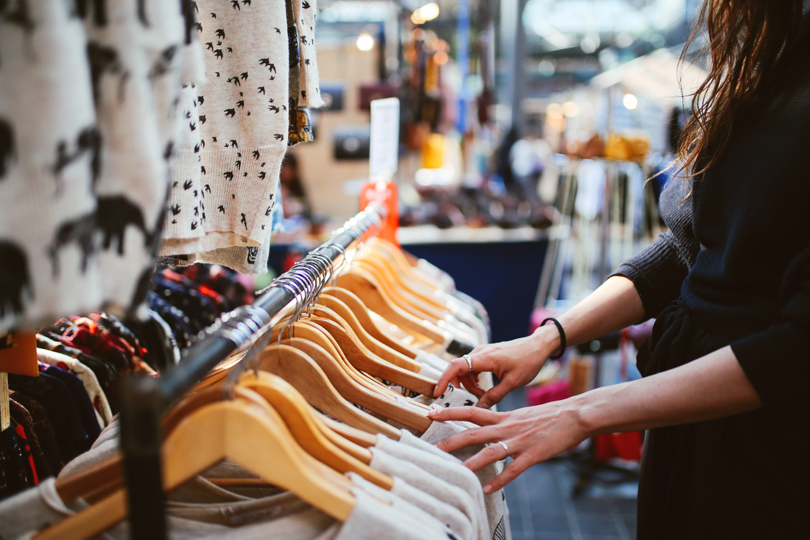The Old Made New: The Importance of Thrifting

Vintage toned portrait of a young beautiful brunette woman in London second hand marketplace. She is wearing casual clothes, black knitted sweater, looking through the second hand market stalls.
Courtesy of 29 Secrets
By Elliana Arnold
The newest trend in shopping involves bringing back the old. Thrifting has become a favorite pastime for many Americans, swiftly growing in popularity these past few years.
Gen Z youths are the ones largely driving this major growth. American University’s publication, The Blackprint, states that currently, “83% of Gen Z Americans already shop or are willing to thrift secondhand items.”
From desiring to shop more sustainably to seeking discounted, unique clothes, thrift shops attract all kinds of people to their doors. The practice of thrifting helps reduce the large amount of waste created by the fashion industry, preserve the environment from dangerous manufacturing processes, and encourages people to discover affordable, inimitable clothing.
For starters, thrifting helps to combat the hyper consumerist culture that is perpetuated in America. Today, people are buying vast amounts of clothing, and according to Abigail Beall, a Features Correspondent for BBC, “the average consumer now buys 60% more clothing than they did 15 years ago.”
Beall continues by explaining that due to the changing trends, most clothing will have a lifespan of only about 2-10 years, for many clothes will shift rapidly from people’s shopping carts and closets to the forgotten landfills. Most consumers buy large amounts of clothes just to discard them in the trash a few years later. The United States Environmental Protection Agency estimates that in 2018, landfills received about 11 million tons of discarded textiles. Beall breaks this number down, stating that annually, the average American throws away approximately 37 kg of clothing.
The overconsumption of textiles and the growth of fast fashion in this country has led and will continue to lead to an enormous amount of waste. According to the Environmental Center at the University of Colorado Boulder, this waste does not decompose easily due to its synthetic nature, potentially taking centuries to complete the process.
Hoping to combat this excessive waste of textiles, many sustainability organizations, such as Goodwill, promote thrifting and donating, suggesting that people give a new home to these discarded products. Goodwill asserts that by buying second-hand items, “you are not directly supporting the demand for new things to be made.” This practice may be small, but it has the power to change many people’s shopping habits to become more sustainable.
Keeping down the demand for more clothes by thrifting also protects the environment, which has been put under strain due to the large generation of new products. The United Nations Climate Change sector asserts that the fashion industry “contributes to around 10% of global greenhouse gas emissions” due to its production process. Additionally, the dyes and chemicals used on the fabrics can harm the environment and subsequently people’s health.
The manufacturing of clothes also consumes a vast amount of water. The UN explains, “To make just one pair of denim jeans, 10,000 liters of water is required to just grow the one kilo of cotton needed for the pair of jeans.” A single person could not drink this much water in less than a decade.
The textile industry is responsible for significant consumption and waste of the world’s resources, just for these clothes to be quickly discarded by consumers later. By thrifting, a person can both reduce the amount of clothing that heads to the landfills and reduce the high demand for trendy styles that will quickly go out of fashion.
Gen Z youths, especially college students, make thrifting a part of their sustainable shopping practices because of their awareness of how the fashion industry affects the environment. James Reinhart, the founder and CEO of thredUP, an online resale site, comments, “When you look at the young, they care about the planet. They care about sustainability. They care about making good choices for their future.”
Besides the environmental reasons for why people adopt thrifting as a sustainable habit, the desire to discover more affordable, unique clothes drives many people to secondhand stores. Most thrift shops have significantly marked down prices that appeal to many consumers, and people often experience the thrill of finding special statement pieces no one else has. The exhilaration of the hunt for new finds prompts many to scour the racks of discarded treasures, for most thrift stores have a large selection of diverse styles to explore.
So check out your local thrift stores today and make sustainable, secondhand shopping a vital part of your life.






